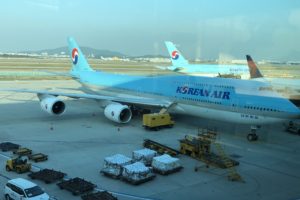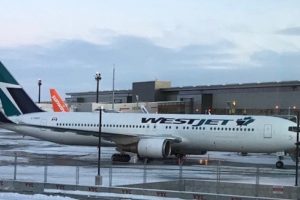Airline Profile: Japan Airlines
The Facts:
| Founded | 1951 |
| Alliance | Oneworld |
| Hubs | Tokyo Haneda Tokyo Narita Osaka Kansai Osaka Itami |
| Headquarters | Tokyo, Japan |
| Fleet Count | Around 164 |
| Skytrax Rating | 5 (out of 5) |
| Subsidiaries | J-Air (regional) Japan Air Commuter (regional) Japan Transocean Air Hokkaido Air System Ryukyu Air Commuter |
| Travel Classes | Short Haul: Economy Class Class J (Premium Economy) First Class (really much more like business) Long Haul: Economy Class Premium Economy Business Class First Class (777-300ER Only) |
| Frequent Flyer Program | JAL Mileage Bank |
| Website | http://www.nl.jal.co.jp/nll/en/ |
| Type of Airline | Full Service Carrier |
| Competitors | All Nippon Airways |

Analysis:
Travel Classes:
Domestic:
Economy Class:
JAL labels their newer domestic economy seats as JAL Sky Next, which are actually slimline seats. Domestic flights on Japan Airlines feature no meal service (free or for purchases). On longer flights, only a beverage service is available. On all domestic flights, wifi is available free of charge, and entertainment options such as movies are also available free of charge via inflight wifi. Domestic economy on JAL is pretty bare bones and might even be similar to what you would find on American low
Class J:
First of all, I am a bit confused over Class J on JAL (It’s called Class J because J class is generally a technical fare class for business). Is it supposed to be a business class or a premium economy class, as the service is not really better than economy, but the seats certainly are? I don’t wholly know what Class J is intended to be, but here is what my understanding of it is: There is no service difference between economy class and Class J. You don’t get meals, but entertainment (via wifi) and drinks are free. However, you do get a larger seat with more room, more recline, and leg rest. I would put it in a category similar to Spirit Airlines Big Front Seats, as you get the same economy class service, but just a larger seat. Should you buy it? It all depends on the price, as always. Sometimes it is only $40 more expensive than economy, though sometimes it can be hundreds of dollars more than economy. 10% more miles are earned in Class J than in economy. Since domestic flights in Japan are no more than a couple of hours maximum, it would probably be wise to stick to economy unless you get a great deal in Class J.

First Class:
Domestic first class on JAL is featured on some domestically configured Boeing 777-200s and 767-300s. It features recliner seats with leg rests in a 2-2-2 configuration (777) or in a 2-1-2 configuration (767). Since Class J has no elevated service, first class is really the only cabin that has premium service on domestic flights. Passengers receive full free hot meals (the only cabin that receives a meal) and more drink options which are free. 50% more miles are earned in first class than in economy. Headphones, mobile batteries, pillows, slippers, and newspapers are also available to first class passengers. Passengers in first class can visit JAL domestic lounges. Since it doesn’t cost that much more (only a couple hundred more than economy), if you really want a premium experience on domestic flights, I would actually recommend taking first class.
Domestic first class is only available on some flights from flights from Tokyo Haneda to:
- Fukuoka
- Sapporo (New Chitose)
- Osaka (Itami)
- Okinawa (Naha)

International:
Economy Class:
Personal on demand entertainment is featured on most if not all international flights on JAL in all travel classes, including economy. Entertainment includes tv shows, video games, movies, e-books, and audio books. Passengers receive light amenity kits with toothbrushes, toothpaste, ear plugs, and eye masks. I personally commend JAL for giving economy class passengers amenity kits, as most other airlines do not. As on most other airlines, food and drinks are free of charge on international flights. Additionally, power outlets and wifi are available on all international flights.
Boeing 787-8s and Boeing 787-9s have an 8 abreast economy class section, which is much wider than on most airlines on 787s which have economy class sections with 9 abreast seats. I personally think that this is one of the few examples in the modern commercial aviation where an airline chose passenger comfort over more seats. Well done in this sense, JAL!
Premium Economy:
Premium economy on JAL is featured on international Boeing 777-200ERs, Boeing 777-300ERs, Boeing 787-9s, and on some Boeing 787-8s. It features leg rests, foot rests, headrests, more legroom, and more seat width than in economy. Premium economy is in a 2-4-2 configuration on 777s and is in a 2-3-2 configuration on 787s. More meal and beverage options are available in premium economy than in regular economy. Premium economy passengers have the same amenity kits as in economy along with slippers which are not featured in economy. Along with its competitor ANA, passengers in premium economy have access to pre flight lounges. Most other airlines do not offer lounge access to premium economy passengers.

Business Class:
Seats: Japan Airlines has a lot of different types of business class seats. See below for a listing of all of them:
Sky Suite: This seat is featured on all 777-300ERs and in some Boeing 787s. It features Apex Suites in a 2-2-2 configuration (787) or in a 2-3-2 configuration (777). However, the configuration is staggered, so all passengers receive all aisle access, including passengers in the middle seat. Since the configuration is staggered and there are seat dividers, window seat and middle seat passengers get lots of privacy compared to aisle seats. See the picture below for clarification. If you select a window seat, the Apex Suite is one of the most private business class seat on the market. I would qualify this as the best business class seat on JAL. If

Sky Suite II: is featured on most internationally configured Boeing 767s. It features flat bed suites in a 1-2-1
SkySuite III: This seat is available on most Boeing 777-200s and some Boeing 787-9s. It features reverse herringbone seats in a 1-2-1 configuration with all aisle access and is similar to the business class seats on American Airlines’ 777-200s. While the seat was introduced after JAL’s Sky Suite Is, I would qualify it to be slightly worse than their Apex Suites which are available on some of their Boeing 777-300ERs and 787s.
Shell Flat Neo: These seats are available on some Boeing 787-8s and features angle flat seats in a 2-2-2 configuration. The seat actually isn’t angled that much, however, it definitely does not qualify as a flat bed seat. Aircraft with these seats are flown on long-haul routes such as its flight from Tokyo to San Diego and Vancouver. While the Shell Flat Neo seat is acceptable in business class on flights less than six hours, for the amount you pay in business class, it most certainly is not acceptable on transpacific flights. If possible, on long-haul flights, avoid taking the Shell Flat Neo seat and instead try and find a plane that has one of their Sky Suites.

Shell Flat: seat is on one Boeing
Skyrecliner: This seat is featured on select Boeing 767s and features recliner seats with leg-rests. It features recliner seats in a 2-2-2 configuration and is flown on a few short-haul international routes to South Korea, China, and Taiwan. I would qualify this as the second worst business class seat on JAL.
SkyLuxe: This seat is on all aircraft without any of the other features mentioned above. It features recliner seats which are less technologically advanced than the SkyRecliner. I would qualify this as the worst business class seat on JAL.
The Soft Product: As happens on every single other airline, business class features better food and beverages than in lower cabins such as economy or premium economy. Passengers have access to Japan Airlines and Oneworld lounges. Additionally, amenity kits with toothbrushes, toothpaste, eye masks, ear plugs, tissues, and slippers are provided on longer routes.
First Class:
International first class is only available on the Boeing 777-300ER. First class features open suites in a 1-2-1 configuration. Honestly, open suites are not the best seats in terms of first class, as many airlines feature closed suites in first class. First class passengers also receive lounge wear (not featured in business class) in addition to amenity kits similar to the ones in business class. Food and beverages are better than in business class. I would say that since first class is only available on the 777-300ER, it is a waste of money to upgrade to first as business class on that aircraft features a fantastic business class hard product.
First class is available from:
Tokyo Haneda To:
- London
- Paris
- New York
- San Franciso
Tokyo Narita To:
- New York
- Chicago
- Los Angeles

Have you ever flown on Japan Airlines? Share about your experience below!




